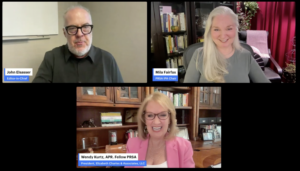“A lot of us went independent because we were pushed off a cliff,” Mila Fairfax said. “I went independent in 2007. I had been with the American Red Cross, and their funding for my role ended.”
Fairfax, principal of Fairfax Image in Walnut Creek, Calif., and chair of PRSA’s Independent Practitioners Alliance (IPA), was a guest for the Aug. 26 Strategies & Tactics Live, PRSA’s monthly livestream on LinkedIn.
Also on the program, Wendy Kurtz, APR, Fellow PRSA, and program chair for the IPA, said going solo was her choice. “I always say you come to independent life one of two ways: by force or by choice,” she said. Kurtz, president of Elizabeth Charles & Associates in Orlando Fla., helps executives become published authors and get paid to speak.
John Elsasser, editor-in-chief of PRSA’s award-winning Strategies & Tactics publication and host of S&T Live, asked Fairfax and Kurtz how they found their communications niches and then communicated that value to potential clients.

“We’re trained as generalists in our communications skills, but we function as specialists,” said Fairfax, who focuses on crisis and reputation PR. “Once you’ve done something a few times, you start to recognize its nuances, and your niche and specialization develop value.”
Kurtz’s advice to independent PR practitioners is to determine “the things that you enjoy doing, not just what you’re good at.” One reason to go solo is to have control over the kind of work that you do, she said.
Finding time to grow your practice
Elsasser asked how independent PR practitioners can pursue new business while still getting their current work done.
“Don’t get so focused working in the business that you forget to work on the business,” Kurtz said. “You may have all the work you can handle, but a client can suddenly lose funding and pull their contract, or you could decide that this isn’t a client you’re comfortable working with anymore.”
Without a pipeline of new business, “you can find yourself in trouble,” Kurtz said. “I’ve heard people say, ‘I don’t have the time’ [to cultivate new clients], but you have to make the time. You have to work on the business almost as much as you do in the business.”
But like actors choosing a script, “You don’t have to take every project that rolls your way,” Fairfax said. “You’re curating a body of work. That’s the reputation you build.”
Sometimes, you might think you’ve landed a dream client, only to find “they’re high-maintenance, they’re expensive, and they breath fire and scorch everything around them,” Fairfax said.
Elsasser asked how solo PR practitioners can avoid feeling isolated and build support networks for themselves and their businesses.
As Fairfax explained, PRSA’s IPA offers “Indie Chat,” a twice-weekly Zoom call where solo PR pros can connect and share ideas. “My business has evolved by orders of magnitude from the advice and counsel that I have gotten through my peers and colleagues in Indie Chat,” she said.
For Kurtz, “getting out and getting involved” in business chambers and associations has helped her business grow. “The people who tend to benefit most are the ones who get involved and give the most,” she said.
Here, Fairfax and Kurtz field questions in the S&T Live lightning round:
Photo: pikselstock














